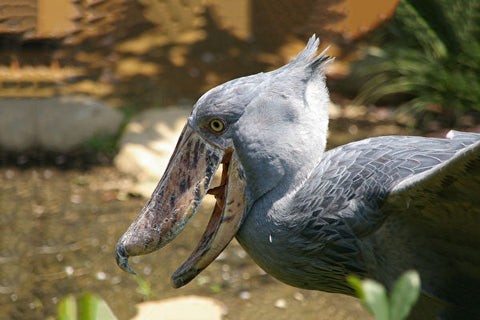The shoebill stork, a bird of peculiar majesty, often captures the imagination with its prehistoric appearance and immense, clog-shaped bill. Officially known as Balaeniceps rex, and sometimes called the whalebill or shoe-billed stork, this creature is truly a marvel of the avian world. Naturally, such a unique animal might spark curiosity about keeping one. But, Can You Have A Shoebill Stork As A Pet? Let’s dive into the fascinating facts about shoebills and address this question directly.
Understanding the Shoebill Stork: Nature’s Masterpiece
What exactly makes the shoebill so special? It’s undeniable that the most striking feature is its enormous bill, resembling a Dutch clog. This formidable tool, up to a foot long and five inches wide, is not just for show. Its tan color with brown markings, sharp edges, and a hooked tip are perfectly adapted for seizing substantial prey in their swampy habitats. Shoebills are adept hunters, feeding on lungfish, tilapia, eels, and even snakes.
Despite their imposing size – they can stand up to 1.5 meters tall and weigh around 7 kg – shoebills possess the power of flight. While they may not be frequent or long-distance flyers, their ability to take to the skies is nonetheless impressive for such a large bird.
Shoebills in the Wild and Captivity: Rarity and Conservation
Encountering a shoebill stork in its natural habitat is an incredibly rare experience. These birds inhabit the remote and diminishing swamp regions of East Africa, from South Sudan to Zambia. Classified as Vulnerable, the shoebill population is estimated to be between 3,300 and 5,300 mature individuals, and sadly, their numbers are decreasing. Habitat loss and human disturbance are major threats to their survival.
While spotting a shoebill in the wild is difficult, there are limited opportunities to see them in captivity. A few zoos around the world house small groups of these birds, offering a glimpse into their unique world. In the United States, Zoo Tampa in Florida is notably one of the few places where you can observe shoebill storks.
The Question of Pet Ownership: Legality and Ethics
Now, back to the central question: can you own a shoebill stork as a pet? The answer is a resounding no.
Several critical factors prohibit keeping shoebills as pets:
- Endangered Species Status: Shoebill storks are listed as a vulnerable species. This protected status, both internationally and in their native regions, makes it illegal to own one privately. Conservation laws are in place to protect these dwindling populations from further decline.
- Ethical Concerns: Removing a shoebill from its natural habitat for personal ownership would be detrimental to conservation efforts and ethically questionable. These birds belong in the wild, contributing to their ecosystem.
- Specialized Care Requirements: Shoebills are wild animals with very specific needs regarding diet, habitat, and environment. Providing adequate care for such a creature in a domestic setting is exceptionally challenging and likely impossible for the average person. Wildlife sanctuaries are better equipped to handle the complexities of their care, requiring dedicated professionals and resources.
While owning a live shoebill is not an option, for those captivated by these magnificent birds, there are alternative ways to appreciate them. Visiting zoos with shoebill exhibits or supporting conservation organizations dedicated to their protection are positive actions. And, if you’re simply looking for a shoebill companion in your home, a stuffed shoebill plush toy can be a delightful and responsible alternative!
In conclusion, while the idea of having a shoebill stork as a pet might be intriguing, it is neither legal nor ethical, and practically impossible. These incredible birds deserve our respect and protection in their natural wild habitats.

